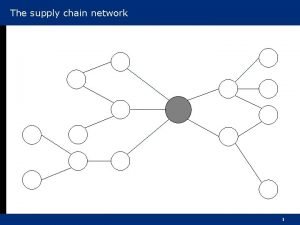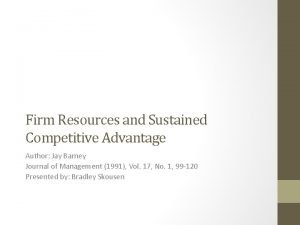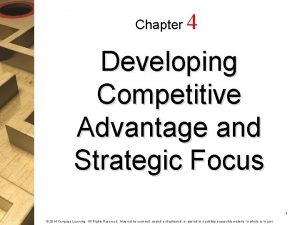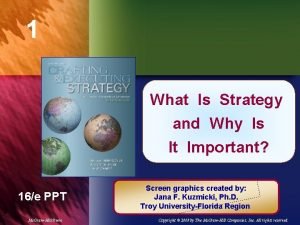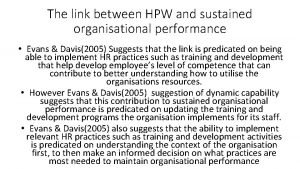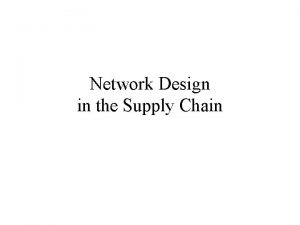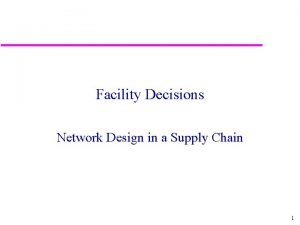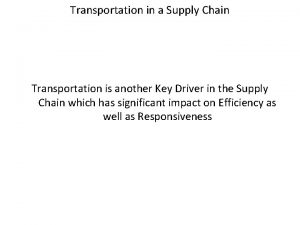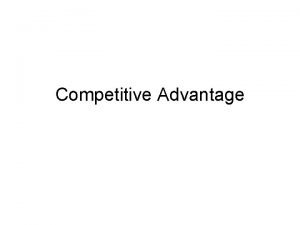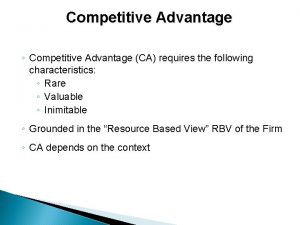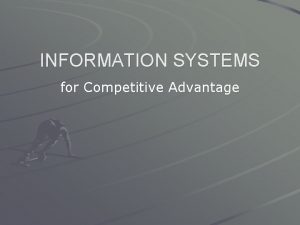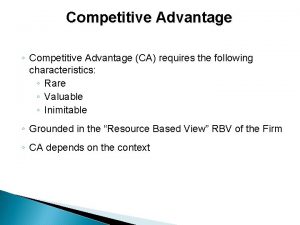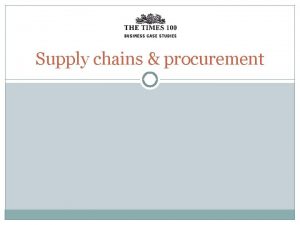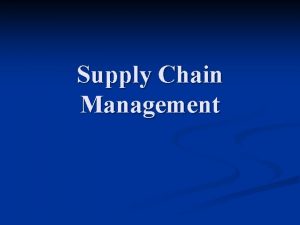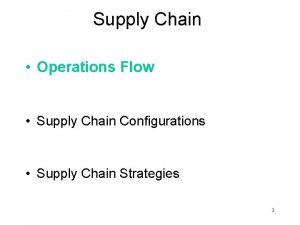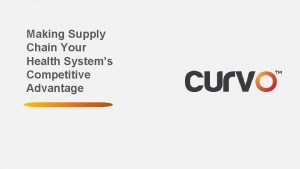The supply chain network 1 Competitive advantage and














- Slides: 14

The supply chain network 1

Competitive advantage and the ‘Three Cs’ Customers Needs seeking benefits at acceptable prices Va ue lu l a V Assets and utilisation Company Cost differentials e Assets and utilisation Competitor Source: Ohmae, K. , The Mind of the Strategist, Penguin Books, 1983 2

Real costs per unit The experience curve Cumulative Volume 3

Logistics and competitive advantage High Value advantage Low High Cost advantage 4

Supply chain excellence High Relative Differentiation Low High Low Relative Delivered Cost 5

Gaining competitive advantage through logistics Value Advantage Logistics Leverage Opportunities: • Tailored service • Reliability • Responsiveness, etc The goal: superior customer value at less cost Cost Advantage Logistics Leverage Opportunities: • Capacity utilisation • Asset turn • Schedule integration 6

The value chain Firm infrastructure Support activities Human resource management Technology development Margin Procurement Inbound Operations Outbound Marketing Services logistics & sales logistics Primary activities Source: Reprinted with the permission of The Free Press, a division of Simon & Schuster, Inc. from Competitive Advantage by Porter, M. E. Copyright © 1985 by Porter, M. E. All Rights reserved 7

Logistics management process Materials flow Suppliers Procurement Operations Distribution Customers Requirements information flow 8

Achieving an integrated supply chain Stage One: Baseline Material flow Purchasing Customer service Material Control Production Stage Two: Functional Integration Material flow Materials Management Manufacturing Management Distribution Manufacturing Management Customer service Distribution Stage Four: External Integration Material flow Suppliers Distribution Customer service Stage Three: Internal Integration Material flow Materials Management Sales Internal Supply Chain Customer service Customers 9

Investing in process excellence yields greater benefits Product excellence (%) 100 Revised emphasis Current emphasis 100 Process excellence (%) 10

Demand uncertainty Demand supply uncertainty High Low High Supply uncertainty 11

Inventory profile of the automotive supply chain (UK 1999 Figures, Volume Car Stock Levels Inbound Logistics Vehicle Manufacturers Outbound Logistics Distribution & Retail Days of Inventory First Tier Supplier Source: Holweg, M. and Pil, F. K. , The Second Century, MIT Press, 2004 12

The four pillars of supply chain excellence Supply Chain Excellence Responsiveness Reliability Resilience Relationships 13

Managing the ‘ 4 Rs’ Responsiveness : Time-based competition is now the norm. The focus is on agility. Reliability : Unreliable processes create uncertainty and variability. Equally, lack of visibility adds to uncertainty. Resilience : Today’s turbulent and volatile markets require supply chains that are capable of dealing with the unexpected and the unplanned. Relationships : As supply chains become more complex and as out-sourcing increases dependency on suppliers, the need for relationship management increases. 14
 Value advantage in supply chain management
Value advantage in supply chain management Matching supply and demand in supply chain
Matching supply and demand in supply chain Value chain and supply chain difference
Value chain and supply chain difference Competitive antagonist
Competitive antagonist Slow-cycle market companies examples
Slow-cycle market companies examples Least competitive market
Least competitive market Firm resources and sustained competitive advantage
Firm resources and sustained competitive advantage Developing competitive advantage and strategic focus
Developing competitive advantage and strategic focus Porters 3 generic strategy
Porters 3 generic strategy A company strategy and its quest for competitive advantage
A company strategy and its quest for competitive advantage Link between hpw and sustained organisation performance
Link between hpw and sustained organisation performance Sequence of food chain
Sequence of food chain Framework for network design decisions
Framework for network design decisions Facility decisions
Facility decisions Milk run vs cross docking
Milk run vs cross docking
